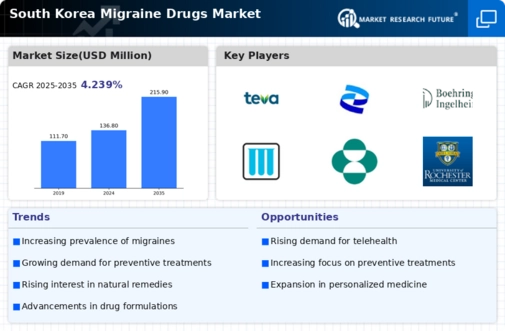Rising Healthcare Expenditure
The increase in healthcare expenditure in South Korea is a vital driver for the migraine drugs market. As the government and private sectors allocate more funds towards healthcare, patients gain better access to medical services and treatments. This trend is particularly relevant for migraine sufferers, who often require ongoing treatment and management strategies. The rise in healthcare spending has also led to improved insurance coverage for migraine medications, making them more affordable for patients. Consequently, the migraine drugs market is likely to benefit from this trend, as more individuals seek effective treatments for their migraine conditions, ultimately enhancing their quality of life.
Growing Awareness and Education
In South Korea, increasing awareness and education regarding migraine disorders are pivotal in shaping the migraine drugs market. Public health campaigns and educational initiatives by healthcare professionals have contributed to a better understanding of migraine symptoms and treatment options. This heightened awareness encourages individuals to seek medical help, leading to an uptick in prescriptions for migraine medications. Moreover, the availability of information through digital platforms has empowered patients to engage in discussions about their treatment options with healthcare providers. As a result, the migraine drugs market is likely to experience growth, as more patients are diagnosed and treated effectively, reducing the burden of this condition on society.
Increasing Incidence of Migraine
The rising incidence of migraine in South Korea is a crucial driver for the migraine drugs market. Recent studies indicate that approximately 10% of the population experiences migraines, with a notable prevalence among women aged 18-44. This growing patient base necessitates effective treatment options, thereby propelling demand for various migraine medications. The increasing awareness of migraine as a significant health issue has led to more individuals seeking medical advice and treatment. Consequently, pharmaceutical companies are focusing on developing innovative drugs to cater to this expanding market. The migraine drugs market is likely to witness substantial growth as healthcare providers emphasize the importance of addressing this debilitating condition, which can severely impact quality of life and productivity.
Regulatory Support for New Treatments
Regulatory support for the approval of new migraine treatments is a significant driver for the migraine drugs market. The South Korean government has streamlined the drug approval process, facilitating quicker access to innovative therapies for patients. This supportive regulatory environment encourages pharmaceutical companies to invest in the development of new migraine medications, knowing that they can bring their products to market more efficiently. Additionally, the government's focus on improving healthcare access and outcomes aligns with the need for effective migraine treatments. As a result, the migraine drugs market is poised for growth, with an increasing number of new therapies expected to enter the market in the coming years.
Advancements in Pharmaceutical Research
Innovations in pharmaceutical research are significantly influencing the migraine drugs market. The development of new drug formulations and delivery methods has enhanced treatment efficacy and patient compliance. For instance, the introduction of CGRP inhibitors has revolutionized migraine management, providing patients with more effective preventive options. Furthermore, ongoing clinical trials in South Korea are exploring novel therapeutic targets, which may lead to the approval of additional migraine medications. This dynamic research environment fosters competition among pharmaceutical companies, driving them to invest in R&D to capture market share. As a result, the migraine drugs market is expected to expand, with a diverse range of treatment options becoming available to patients.
























Leave a Comment